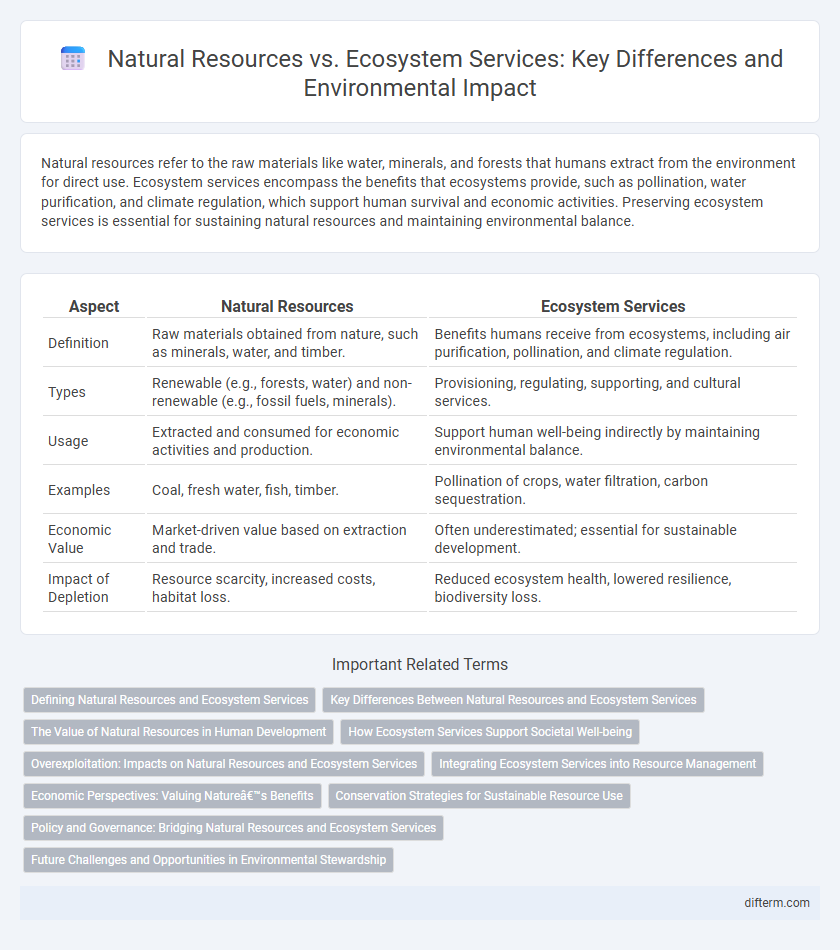Natural resources refer to the raw materials like water, minerals, and forests that humans extract from the environment for direct use. Ecosystem services encompass the benefits that ecosystems provide, such as pollination, water purification, and climate regulation, which support human survival and economic activities. Preserving ecosystem services is essential for sustaining natural resources and maintaining environmental balance.
Table of Comparison
| Aspect | Natural Resources | Ecosystem Services |
|---|---|---|
| Definition | Raw materials obtained from nature, such as minerals, water, and timber. | Benefits humans receive from ecosystems, including air purification, pollination, and climate regulation. |
| Types | Renewable (e.g., forests, water) and non-renewable (e.g., fossil fuels, minerals). | Provisioning, regulating, supporting, and cultural services. |
| Usage | Extracted and consumed for economic activities and production. | Support human well-being indirectly by maintaining environmental balance. |
| Examples | Coal, fresh water, fish, timber. | Pollination of crops, water filtration, carbon sequestration. |
| Economic Value | Market-driven value based on extraction and trade. | Often underestimated; essential for sustainable development. |
| Impact of Depletion | Resource scarcity, increased costs, habitat loss. | Reduced ecosystem health, lowered resilience, biodiversity loss. |
Defining Natural Resources and Ecosystem Services
Natural resources refer to raw materials obtained directly from the Earth, such as minerals, water, forests, and fossil fuels, which are essential for human survival and economic activities. Ecosystem services encompass the benefits that humans receive from ecosystems, including provisioning services like food and water, regulating services such as climate regulation and flood control, cultural services involving recreational and spiritual benefits, and supporting services like nutrient cycling and soil formation. Understanding the distinction between natural resources as tangible inputs and ecosystem services as functional benefits is crucial for sustainable environmental management and conservation strategies.
Key Differences Between Natural Resources and Ecosystem Services
Natural resources are tangible materials like minerals, water, and timber that humans extract and use directly, whereas ecosystem services are the benefits humans receive from ecosystems, such as pollination, climate regulation, and water purification. Natural resources are finite and can be depleted, while ecosystem services are processes maintained by healthy ecosystems and often operate continuously. Understanding the distinction highlights the importance of conserving both resource availability and ecosystem functionality for sustainable environmental management.
The Value of Natural Resources in Human Development
Natural resources such as minerals, water, and forests provide essential raw materials and energy that drive economic growth and infrastructure development. Ecosystem services like pollination, water purification, and climate regulation support agriculture, health, and livelihoods, maintaining the balance necessary for sustainable development. The intrinsic value of natural resources is amplified by their ability to sustain ecosystem services that underpin human well-being and long-term prosperity.
How Ecosystem Services Support Societal Well-being
Ecosystem services provide essential benefits such as clean air, water filtration, climate regulation, pollination, and soil fertility, directly supporting human health and agricultural productivity. These natural processes maintain biodiversity and resilience, ensuring long-term availability of natural resources like timber, fish, and freshwater. By sustaining these services, ecosystems uphold economic stability, food security, and overall societal well-being.
Overexploitation: Impacts on Natural Resources and Ecosystem Services
Overexploitation of natural resources disrupts ecosystem services by depleting biodiversity and impairing functions such as water purification, soil fertility, and carbon sequestration. Excessive harvesting of forests, fisheries, and freshwater reduces ecosystem resilience, resulting in habitat loss, reduced productivity, and increased vulnerability to climate change. Sustainable management practices are essential to maintain the balance between resource extraction and ecosystem service provision for long-term environmental health.
Integrating Ecosystem Services into Resource Management
Integrating ecosystem services into natural resource management enhances sustainable use by valuing benefits such as water purification, carbon sequestration, and soil fertility alongside tangible resources like timber and minerals. This approach promotes holistic decision-making that accounts for ecological functions and biodiversity, ensuring long-term resilience of both human and natural systems. Effective management frameworks incorporate ecosystem service assessments to optimize resource allocation and mitigate environmental degradation.
Economic Perspectives: Valuing Nature’s Benefits
Economic perspectives quantify natural resources as tangible assets with market value, while ecosystem services represent intangible benefits essential for human well-being. Valuing nature's benefits involves assessing provisioning, regulating, cultural, and supporting services that underpin economic activities and societal health. Integrating these values into policy and business frameworks promotes sustainable management and incentivizes conservation efforts.
Conservation Strategies for Sustainable Resource Use
Conservation strategies for sustainable resource use emphasize the integration of natural resource management with ecosystem services preservation to maintain biodiversity and ecosystem resilience. Implementing adaptive management practices, such as habitat restoration and sustainable harvesting, enhances the regeneration capacity of renewable resources while safeguarding essential services like water purification, pollination, and climate regulation. Prioritizing ecosystem-based approaches and community involvement ensures that resource extraction does not compromise ecological functions critical for long-term environmental health and human well-being.
Policy and Governance: Bridging Natural Resources and Ecosystem Services
Effective policy and governance frameworks are essential to harmonize natural resource management with ecosystem services preservation, ensuring sustainable development. Integrating ecosystem service valuation into natural resource policies enables informed decision-making that balances economic growth and environmental conservation. Collaborative governance models promote stakeholder engagement and adaptive management, enhancing resilience and long-term resource availability.
Future Challenges and Opportunities in Environmental Stewardship
Balancing natural resources extraction with ecosystem services preservation presents critical future challenges in environmental stewardship, as unsustainable exploitation threatens biodiversity and climate stability. Innovative strategies integrating renewable resource management, ecosystem restoration, and valuation of ecosystem services offer opportunities for sustainable development and resilience against environmental degradation. Advancing policies that align economic incentives with ecosystem health will be essential to securing long-term environmental sustainability and human well-being.
natural resources vs ecosystem services Infographic

 difterm.com
difterm.com